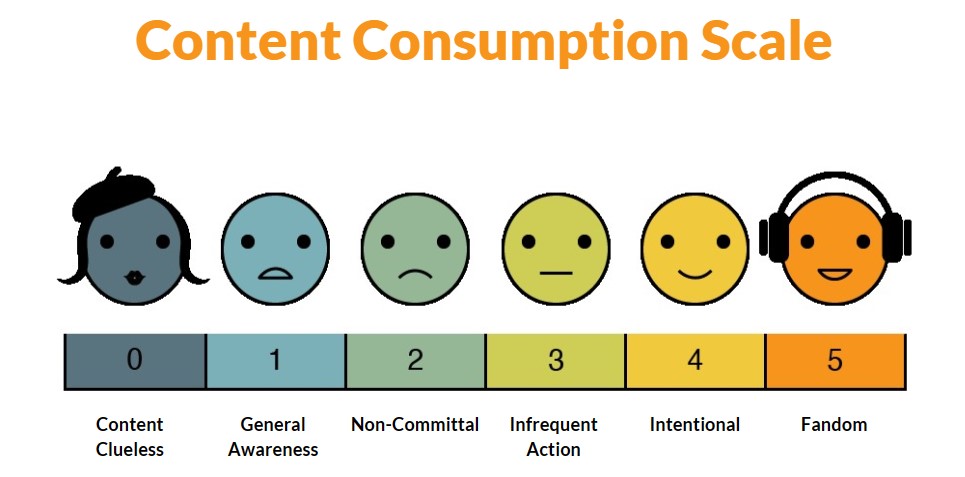This article is co-authored by Digital River Media CEO Annie Murmann and COO Jeneanne Ballos.
You diligently developed your customer personas, carefully selected relevant keywords, and added funny memes to your content strategy. But as you confidently present the content plans to the CEO, you can’t help but notice their confusion. At the end of the presentation, they clear their throat and say, “This all seems fine, but I don’t know how it’s going to bring in $5,000 in sales.”
Your heart sinks as you realize: “My CEO is ‘content clueless.’”
It’s no easy task to win over stakeholders who don’t understand the art or nuance of content marketing or how it works to make a meaningful business impact.
Fortunately, as a content leader, you’re a pro at educating and persuading audiences to take a desired action.
By constructing your buy-in conversation around these six strategies, you can convince clueless stakeholders to endorse the content plans and give the support to execute them.
6 strategies to convert the content clueless
Although encountering content-clueless stakeholders can be discouraging, see it as an opportunity to improve the relationship between your content team and the organization’s leadership. These six strategies can help you convert those naysayers into passionate, active content champions.
1. Focus on what they gain
Help the content clueless understand how a well-developed content marketing strategy contributes to their priority business goals. Highlight these benefits – and how successful brands have used them – to pique the stakeholders’ curiosity and motivate them to become more enthusiastic advocates:
- Strengthen brand loyalty. Effective content can help bond your company and its customers. LEGO does this with its movies, magazines, and product catalogs achieve. The brand uses content to inspire nostalgia and imagination, deepening the relationship between LEGO and its customers as they evolve into adulthood.
- Boost customer retention. Netflix personalizes its product recommendations based on the customer’s previous likes and dislikes. If you give a thumbs up to Lincoln Lawyer, Netflix might recommend a similar show, Suits, to watch next. It’s no wonder Netflix has one of the lowest subscriber churn rates in the streaming industry despite increases in subscription costs, according to Yahoo Finance.
- Demonstrate industry expertise. Business software company HubSpot offers educational content through HubSpot Academy. This authoritative offering positions the company as a leading industry expert, prompting B2B consumers and prospects to consider HubSpot when they’re in the market for a CRM system or other marketing software sold by the brand.
- Increase sales. Home Depot has mastered using content to enhance its sales. As Convince & Convert President Jay Baer pointed out in his Content Marketing World 2021 keynote, Home Depot’s toilet installation page cross-sells by displaying links for related products and professional plumbing services.
- Create a positive impact. The Cleveland Clinic blog, Health Essentials, is a safe space where readers can discreetly explore credible healthcare content. This platform is a positive resource, empowering readers, their families, friends, and communities to create healthier lifestyles.
2. Meet them where they are
To help the content clueless evolve into content allies, you need to meet them where they are. But how do you know where that is?
Ask questions to determine their level of general content consumption and understanding. What are they fans of? Where do they get information about the topics they are interested in?
Use their answers to determine their score on the content consumption scale (below). Zero represents the content clueless – someone who consumes little to no content about their passion topic. A score of one indicates general awareness, while a two signifies a non-commital view. A three means infrequent action, and a four is intentional. Five represents a content fan – someone who eagerly and regularly consumes content, from email newsletters to videos, books, and blogs.
Once you know the stakeholder’s content consumption score, you can gently increase their level of sophistication by recommending content tailored to their interests and hobbies.
For example, if they are an avid gardener, recommend a gardening podcast. Later in the week, you can say, “Remember that gardening podcast I recommended? I want to launch a similar podcast for our company to help build brand loyalty.”
Your target can better understand the power and value of content by exploring it through the lens of their personal interests. The added perspective might make them more inclined to champion your next strategic initiative.
3. Earn their trust
Building trust with leadership, your team members, and other internal content partners is an increasingly important step in marketing success. It’s also crucial to gaining alignment. As Velocity Partners’s Doug Kessler has said, “Getting stakeholder buy-in isn’t a big fat obstacle to your job; it is your job.”
As content leaders, sometimes you must fight for the privilege of doing the work. That requires getting stakeholders to trust content marketing is the right strategy, the right business to be in, the right investment to make, and the right way to think about solving customer problems.
At the same time, don’t take their lack of trust personally. If you face doubt or distrust in your professional work, it may have little to do with you and everything to do with the human condition.
“Don’t take stakeholders’ lack of trust in content personally. It may have more to do with the human condition than with your work.”
People have only become more distrustful and more skeptical over time. In an episode of their This Old Marketing Marketing podcast, Joe Pulizzi and Robert Rose call this one of the most critical issues content creators face. To counteract that lack of trust, brands increasingly expect to communicate their values through their content and position their expertise in a non-transactional, non-promotional way.
Good content marketing is designed to build trustworthy relationships between brands and customers. Building trust with the content clueless isn’t so different. If you need to start a personal trust campaign with your team, here are ways to do that:
- Be open and transparent about your strategy and tactics. Share information, share power. Remember, they can only learn to trust if you let them in on all the pertinent details.
- Don’t overpromise. Stay strong in your conviction that content marketing is not a magic wand brands can wave at will. Using terms like “silver bullet” or “panacea” doesn’t do anyone any favors.
- Provide realistic estimates. Be upfront about necessary resources, timelines, and success metrics.
- Develop (and document) your strategy – and cite it frequently. Remember that this strategy may need to evolve every quarter, six months, or year.
Just like content marketing is an investment in strengthening relationships and trust with your customers, so is this internal trust-building effort. And it doesn’t happen overnight.
4. Educate to increase understanding
If you are in content marketing, you’ve likely come across the following concepts: “Do not build on rented land.” “Build an audience before products.” “There’s no such thing as too much orange.” We sometimes refer to these as “sacred truths,” but they are not common knowledge. In fact, we joke that content marketers are part of a secret club, decked out in orange (CMI’s signature color) and espousing strange ideologies.
Once you are a believer, it is hard to remember what it was like as an outsider, clueless about these theories.
How do you get others to believe in the power of content marketing? Through education.
Education and disseminating helpful information are core principles. You create a collaborative environment by giving away knowledge, believing a rising tide lifts all boats. But this philosophy starkly contrasts the competitive culture prevalent in many industries and even other marketing disciplines.
When faced with disbelievers, go with what you know best: Use content to explain content marketing. Learn about their interests or sources of friction. Then, help evolve their understanding by providing relevant webinars, books, email newsletters, and other sources of content industry expertise. The more they consume, the more they’ll understand.
5. Speak up in support of your specialized expertise
You might hear comments such as, “Content marketing is easy. Anyone can do it.” The unindoctrinated tend to discount the effort to produce and manage content successfully. They fail to recognize that it requires research, data interpretation, well-honed skills to communicate with an audience, and deep knowledge of multiple business areas.
You need to actively advocate for the expertise by debunking misperceptions. For example, if a co-worker snarkily remarks, “Your job is to only post on TikTok, right?” explain that social media is just one facet of a data-backed strategy that drives results.
Be on the lookout for internal champions. It only takes one conversion, champion, or leader to turn the tide and convince others of your valuable expertise and that content marketing is worthwhile.
“It only takes one conversion, champion, or leader to convince others of your expertise and the value of content marketing.”
6. Acknowledge content is a long game
One of the biggest stumbling blocks for the content clueless might be understanding content marketing is a long game. It requires consistent progress over time. Jesse Cole, the owner and marketing genius behind the Savannah Bananas baseball team, encourages marketers to prioritize long-term fans over short-term profits. We think this should be the content marketing rallying cry!
The content clueless likely wants to see results – sales, signups, downloads, etc. – more quickly.
To help them understand the impact of content, start by using this content marketing return-on-investment formula shared by Ben Jacobson in this Semrush article: Subtract the investment from the total return and divide by the investment. Multiply that number by 100 to get the return on investment percentage.
For example, a video leads to $100,000 in sales. That’s the return. It cost $10,000 to create. That’s the investment. Subtracting the investment ($10,000) from the return ($100,000), you find the video netted $90,000 in revenue. Divide that by the investment ($10,000) and multiply by 100 to find the content marketing ROI, which is 900%.
($100,000 [return] – $10,000 [investment]) x 100 = 900%
While that ROI might feel satisfying, it only relates to sales. It doesn’t account for the video’s other effects – impressions, audience engagement, the number of viewers who visited your website, etc.
Further, this ROI formula isn’t particularly helpful in determining the brand’s top-performing content products, campaigns, and channels. It also can’t track the impact of the video if it was one of many digital touchpoints along the customer journey.
Perhaps the better solution is to be intentional.
Determine your organization’s goals, understand how they align with the overall content strategy, and create a scoring system for the key performance indicators that matter most to your stakeholders. Among the content marketing metrics that can move the organization’s needle:
- Web traffic
- Conversions
- Subscribers
Converting the clueless
While the content clueless can frustrate, they also present an opportunity to convert them into allies. Similar to how you pick and choose methods to create a successful content marketing strategy, you may need to mix and match these six techniques to discover what works best for your content-clueless audience.
Take time to understand them, their motivations, challenges, and fears. It may not be quick or easy, but it will be worth it. Don’t forget to lean into your content marketing superpower – something that sets you apart from everyone else: the amazing support the industry professionals provide each other.
For a deeper dive into these six strategies, use code JODI200 for $200 off registration for a Content Marketing World on-demand pass. You’ll get access to this presentation – and dozens more from top content marketing leaders and experts.



